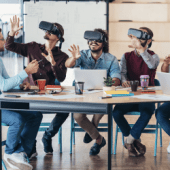Protiviti-The Financial Times Directors’ Roundtable: An “evolved workplace” is a board’s responsibility
IN BRIEF
- The tables have turned: Successfully engaging your workforce requires a change in mindset, reversing the power dynamic from top-down to one that is increasingly employee-centric.
- Think holistically: Employee care extends to mental health and the ecosystem supporting workers at home.
- It’s a continuous effort: The board’s focus on human capital strategy should not end when the crisis ends.
The Financial Times, in association with Protiviti, hosted a digital roundtable as part of the Outstanding Directors Exchange conference held late in 2021 and focused on how companies are adapting to the post-pandemic "evolved workplace" and a way of working that is quite different in many respects. The discussion, moderated by Peter Richardson, Managing Director and architect for the future of work at Protiviti, brought together a dozen public company directors from diverse industries—including technology, financial services, mining and utilities, consumer product goods, and retail—for a board-level discussion of what’s possible and the implications for culture, technology, physical space and talent.
For knowledge workers in particular, work is no longer inextricably linked to a physical location, and many are keen to retain some of the flexibility and autonomy that came with the full-scale move to remote work.
Companies must be mindful of the impact these changes have had on essential workers and those for whom physical presence remains critical. As society reassesses the future of work, will the pendulum swing back to the way companies and individuals operated before? Or will it continue to push forward in a more flexible and technology-enabled direction?
Working through a crisis
From the outset of the discussion, there was clear agreement that the COVID-19 crisis elevated employees to the top of the agenda as companies moved quickly to bring business operations online and provide for those who had to be physically present to work.
The widespread closure of schools and strict rules around travel and quarantines forced employers to acknowledge the demands their employees have outside of their work life, particularly when it comes to caregiving. One attendee cited the introduction of “emergency care lines to provide coverage for unexpected schedule disruptions” and emphasized the importance of companies proactively reaching out to offer this support, rather than employees needing to ask for it.
As another attendee noted, it will be important for employers going forward to understand “the ecosystem behind workers—or the people who support your workers.” When that support is missing, it is very difficult for employees to perform at their best.
An additional lesson learned from the pandemic that will benefit companies in the future is that “having teams that are much more distributed or decentralized created interesting challenges and opportunities for companies.”
For one thing, it “put a lot of pressure on listening channels.” In the absence of face-to-face interaction or water cooler conversations, companies had to think creatively about how to keep a finger on the pulse of the business and their employees in a wide range of areas such as operations or talent retention. Several participants shared their experiences with companies that surveyed their employee base quite extensively and found it to be an effective tool for gauging the temperature of the workforce. Another added that companies would do well to integrate more data into the human capital function, similar to marketing and sales, so that workforce “decisions can be more data-driven than anecdote-driven.”
In the absence of face-to-face interaction or water cooler conversations, companies had to think creatively about how to keep a finger on the pulse of the business and their employees in a wide range of areas such as operations or talent retention.
A shifting mindset for boards
As more companies elevate human capital issues to the boardroom agenda, directors are realizing that attitudes toward work have changed. It is much more important now to provide a work environment that aligns with employees’ values, and “the basis upon which individuals are making decisions to stay or leave a company has evolved.”
Becoming a mission-driven organization is one way companies are helping employees find a purpose beyond just salary. As we saw in the pandemic, offering more money is often not enough to bring workers back. Boards should be working with management to move the needle and “make employees feel more valuable and respected.”
One attendee urged the group to let go of the traditional belief that top-down management is good management. Power dynamics are reversing, and employees increasingly have an outsized impact on key company decisions. A byproduct of this paradigm shift is that individuals are able to mobilize grassroots movements more easily and companies are also seeing culture shifts occur more quickly.
Even a company that historically had very good labor relations ran into difficulty when decisions were made and enforced with a top-down mentality. What should the board have known or done?
Some panelists pushed back at the notion that these developments are surprising, citing a “growing gap between the culture a company believes it has and the culture [it actually has].” In this example, raw data was again mentioned as an important tool for the board to receive an unfiltered view.
Boards need to be defining KPIs and “asking for a people update” in the same manner as they do with customers. How well is the company delivering for employees?
The work is just beginning
The directors present acknowledged that efforts to improve the board’s focus on workforce issues should not end when the crisis ends. As one director summed it up, “it is a continuum.” Flexible work, diversity and inclusion, and mental health are all global, long-term trends that have been part of the human capital dialogue for a while. These issues are not simply part of the crisis or an event, “they are part of a durable trend.”
The introduction of tech tools is making it easier for companies to help employees “find an equilibrium” and proactively offer resources. Mental health support was cited as one area that has become much more involved. Companies can now offer digital therapy or a more personalized “menu of offerings.”
The evolved workplace falls under the purview of today’s boards as it can impact “shareholder value, company reputation, and the long-term best interests” of a company. As one participant noted about recent calls with top shareholders, “without exception every single one wanted to speak about ESG and links to compensation.”
This is very different than even five years ago. It is therefore incumbent on directors to think about their own role when it comes to their duties to the company. Expect the future of work and the workplace to sit solidly atop boardroom agendas for many more years to come.
As we saw in the pandemic, offering more money is often not enough to bring workers back. Boards should be working with management to move the needle and “make employees feel more valuable and respected.”





























